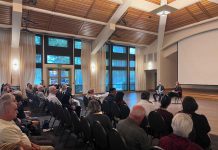Homelessness is a shameful problem in a rich country like ours.
What makes these last two decades remarkable from others is that
homelessness has grown, rather than abated, in the United States in
a period of unprecedented prosperity.
Homelessness is a shameful problem in a rich country like ours. What makes these last two decades remarkable from others is that homelessness has grown, rather than abated, in the United States in a period of unprecedented prosperity. So, after years of helping communities to build a linear “Continuum of Care” for homeless people (a comprehensive program that consists of a continuum in which homeless people progress from emergency shelter to transitional housing to permanent affordable housing), the U.S. Department of Housing and Urban Development (HUD) changed direction with this Republican administration.
It reactivated the Interagency Council on the Homeless, and has established the laudable goal of ending homelessness in 10 years. In fact, HUD has “strongly suggested” that every community receiving its Homeless Assistance funds has in place a “10-year plan to end homelessness.”
Is it possible to end homelessness in 10 years? What would it take for Morgan Hill, Gilroy and San Martin to achieve this? Longtime homeless service providers and advocates believe we can end homelessness if we have three things: Substance abuse and mental health treatment on demand, affordable housing and jobs or subsidies that will help people hold on to their housing.
Sounds too simple. Or, it’s too difficult in this time of budget cuts and reduced services. However, we all know that anything can be achieved if we have the political will. I think we can get there. In order to do so, though, it would take a mind shift.
First, in contrast to the guiding principles behind the linear Continuum of Care, in which homeless people must earn housing through a step-by-step sequence of treatment and transitional housing before they are considered “housing ready,” we must see as the primary problems homelessness and poverty, not people’s symptoms. What’s the difference between an alcoholic who lives in a house, and one who is homeless?
Answer: One is homeless. In other words, a housed alcoholic has the same issues and struggles as a homeless alcoholic. The fact he lives in a house only hides them better than the one on the street. The same goes for someone with mental or chronic illness. The person with mental illness who lives in a house is able to afford treatment and housing. The one on the street cannot.
Life on the streets exacerbates illnesses, causing great cost to the individuals suffering, and to our community and resources, because treatment in crisis intervention is much more expensive. University of Pennsylvania professor Dennis Culhane contrasted the cost of providing supported housing and emergency shelter and services. Put these folks in housing first, which will provide the stability necessary to access the treatment they need, then public costs will be reduced, and benefits to us will increase because we have productive and stable members of the community, rather than dependent people in a state of crisis.
Second, we need truly affordable housing. While South County may have less expensive market rents than the rest of the county, they are still not cheap enough. Also, “affordable housing” is targeted to families making 60 to 80 percent of Area Median Income (AMI). With the AMI for a family of four in Santa Clara County at a staggering $105,500, we have many families who still cannot qualify for the little that’s available.
Moreover, people who are restricted to disability or other income supports can hardly rent a room for themselves. This will become a more pressing issue as our population shifts, as many baby boomers age, live longer, and have limited incomes. We need housing that is targeted to families and individuals at very low and extremely low incomes. This is too rare in our area because housing developers have difficulty obtaining enough subsidies to have housing that inexpensive. What would it take to change that?
Third, we need to stop thinking that “if we build it, they will come.” Gilroy and the South Valley is not a magnet for homeless people. Gilroy has the highest number of homeless people per capita in the county. They are here already. They are our family members, former neighbors, former fellow congregation members. I recognize that some have been alienated from us due to their addictions and contrary behavior. But most of them, frankly, are just plain old poor. They’re hardworking. They love and have dreams for their children to live better lives. What they lack is support and skills.
There are many other steps, but they will follow from these three shifts. We can end homelessness in 10 years. What do you think?







